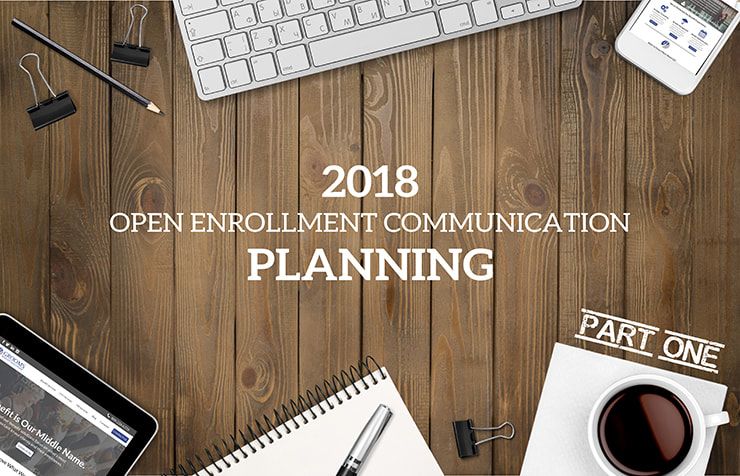|
Goodbye summer, hello fall. To most people these words mean a change in weather, wardrobe, or their favorite fall flavored drink at Starbucks. But to an HR or employee benefit professional, it also means something else… time to start gearing up for Open Enrollment. Never communicate without a strategy.If you’re a Grooms Benefit Solutions client or follower, you’ve been listening to us advise all year about the importance of year-round engagement surrounding employee benefits, and we’re going to assume you’ve been keeping up with your on-going benefit education. Pat yourself on the back, because you’ve given your employees a great head start to the next three months. Now, its game time. When it comes to employee benefits, communication is crucial for ensuring your employees get the most from the benefits you’ve invested so much time and energy into developing. You’ve been working tirelessly over the summer to design your programs to meet specific financial and cultural business goals, but unless you communicate about them effectively, your time and investment will all have been for nothing. The best way to ensure your engaging your employees effectively is to start by having a solid communication strategy. Let’s get one started. Review your successes and failures.Whether you had a detailed communication plan last year (that’s good!), or you flew by the seat of your pants (maybe not so good), it important to revisit what was done and reflect on the successes and/or failures you had. If your team had an open enrollment post-mortem meeting to analyze this already, time to pull out and brush off those notes and review them. Collect everything that was shared with your employees, and we mean everything – PowerPoints, emails, text messages, posters, benefit guides, websites/technology – and put together an internal team to help review their effectiveness. If it’s possible, gather some “peer champions” (a small selection of people from different departments at different levels) onto a team to help get a sense of how EVERYONE felt about last year’s communications. Work with this team to answer some of the following questions:
If it’s not possible to pull together a peer group for this exercise, consider creating an email survey to gather feedback. You can use an online survey provider to build a short survey where employees can answer questions anonymously about their communication preferences. Questions can be broad (How effective were benefit communications last year in helping you make your decisions?) or very detailed (Would you be more likely to read reminders about open enrollment if we texted you instead of emailing you?). Your questions may vary based on the information you are trying to collect, and remember that this is not only a good tool to collect feedback from last year, but also about possible ideas for the future. Set goals and objectives.How do you recognize that your communication plan has “succeeded” or “failed” your organization? By making sure you set goals and objectives that are in line with your company’s overall philosophy. Remember overall company goals should drive HR goals, which in turn, drive employee benefit goals. It’s a domino effect, so make sure your communication goals aren’t coming out of left field, or they may not make sense or matter to the corporate leaders. Figure out your primary objectives (for open enrollment) and your secondary objectives (maybe for company-wide culture improvement?) and identify them up front. Once you’ve got your objectives nailed down, set up a goal and a stretch goal for each one. Goals like “Do Better!”, although easily obtainable, may be a little too broad to measure. Try and be more specific. Maybe your focus this year is to get more people to enroll in the company wellness program? Or maybe you’re attempting to migrate employees into a new plan? You can even be a little self-serving and strive to raise the usage numbers on a benefit technology tool your company has invested money in to show your CFO some juicy ROI. Once you identify your goals, it’s important to think about what might motivate your employees to take the actions needed to achieve them. Think about approaching this in terms of “gains” and “losses”. For example, list out all the things your employees stand to gain if they pay attention and make smarter benefit choices, and all the problems they might be forced to deal with if they don’t. This activity will be your first step towards developing your communication message points. Message like a marketer.We all have iPhones, we all eat McDonalds, and we all wear Nikes, right? And even if you don’t, you still know who I’m talking about, because these monster brands have figured out the secret sauce to create impactful, memorable, and emotional connections with us. We can take some of their lessons learned and apply them here to our benefits communication plans, because at the end of the day just like these huge advertising brands, we want to talk directly to our people. First, segment your audience. You’ll reach your benefit decision-makers more easily and effectively when you target your message directly to them. There is a broad spectrum when it comes to segmentation. You can be extremely detailed and segment down to age, gender, years at the company, past claims data, etc., but this takes major time and resources. A simpler route is to segment into meaningful groups – desk worker/non-desk worker, union/non-union, corporate headquarters/remote workers, etc. Either way, the point is to find a way to tailor your messaging so that it speaks to specific pain points that unique groups of people are feeling. If you can explain to these groups of people “what’s in it for them” they will be more likely to perk up to do what you want them to do. Second, be disruptive. You may be under the illusion that your workforce is a captive audience, but think again. Employees are bombarded with all kinds of requests, from all departments, about a million times a day. Oh, and they also have personal lives competing for attention. If you really want to break through the noise, you need to craft a communications campaign that goes beyond the basic formula of a few emails with PDF attachments. You need to aspire to reach your employees in more surprising ways. Think about branding your benefits by developing a benefit communication theme. Your theme can be based on your company’s culture, style and values, or can draw from pop culture or societal issues. We have seen companies use successful themes that have centered around movie posters, rock bands, presidential elections, and even sporting events. There is absolutely no reason open enrollment communications have to be boring, so have fun with this! Remember, it’s not enough to tell your workforce what benefits and tools you’re offering. Awareness only goes so far. Hopefully you have been promoting awareness through education since last open enrollment, but now is the time to make employees act. You need to motivate them to care - and actively participate - by explaining very clearly why it’s important that they engage. We’ll get into more details on how to do this over the next 6 weeks as we deliver a weekly play-by-play on how to plan for the best open enrollment ever. Author: Kate Grooms, Chief Engagement Officer Before joining the Grooms Benefit Solutions team, Kate specialized in internal communications for global healthcare companies such as Johnson & Johnson, McNeil Consumer Healthcare, and Baxter.
3 Comments
9/11/2018 06:05:06 pm
Hi Kate,
Reply
Kate Grooms
9/26/2018 10:41:05 am
Thanks, Mark! We are very excited to learn more about how Quizzify can help with benefit education and health literacy!
Reply
Dave Molina
10/16/2018 07:32:15 am
Open communication takes place when all the participants are capable of expressing their ideas to one another. I think it is a very crucial part of the workplace. Both managers and workers need to have good communication skill in order to have a profitable calling. When an open communication becomes effective, it creates a greater opportunity for the business to thrive. Ineffective communication will never give you the expected outcome. Better you should follow the strategies designed for making the communication open and effective. And cultivating your active listening skill is the best way to start the groundwork- https://www.reginafasold.com/blog/the-art-of-listening/ .
Reply
Leave a Reply. |
Our WritersWe ask that all employees at Grooms Benefit Solutions contribute ideas to our Insights blog. Everyone here has a voice, and we love that. Topics
All
Inbox Insights
By subscribing, you agree to hear from us once in a while. Unsubscribe at any time. See our full privacy policy here.
Archives
August 2023
|
|
OUR SERVICES
|
OUR CULTURE
|
© 2024 GROOMS BENEFITS - ALL RIGHTS RESERVED
|






